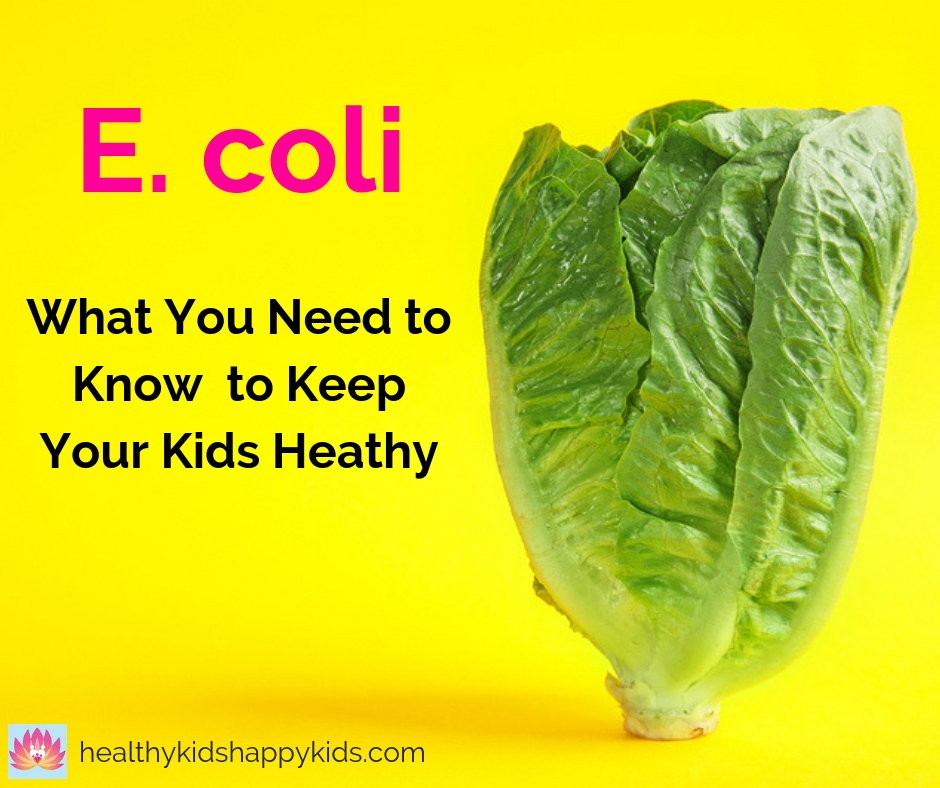
What’s there not to love about a crunchy, delicious Caesar salad topped with shredded chicken, avocado, and cherry tomatoes? E. coli – that’s what…
By now you’ve hopefully read the recent CDC warnings about a multistate outbreak of Shiga toxin-producing Escherichia coli O157:H7 (STEC or E. coli O157:H7) linked to romaine lettuce. The CDC advises people to NOT EAT ANY romaine lettuce for now. So if you have any romaine lettuce at home – throw it out and scrub your produce drawer clean if the romaine wasn’t bagged. If you go out to eat, don’t order anything with romaine lettuce – even your favorite grilled romaine Caesar salad.
What do you need to know about E. coli O157:H7 to keep your family safe and healthy?
Here are the facts:
- There are many strains of E. coli – many of which are harmless, and some of which are actually normal inhabitants in our gut microbiome. The “dangerous” E. coli is referred to as Shiga toxin-producing E. coli (also referred to as STEC), verocytotoxic E. coli (VTEC), or engerohemorrhagic E. coli (EHEC). The most recent E. coli outbreak from romaine lettuce is due to E. Coli O157:H7, which is the most common STEC in North America.
- Illness usually occurs 1-10 days after ingesting food contaminated with the bacteria, with an average incubation time of 3-4 days.
- Symptoms can include fever, severe stomach cramps, diarrhea (often bloody) and vomiting. Infections can be very mild, or potentially life-threatening and can cause kidney failure from hemolytic uremic syndrome (HUS).
- Go to your doctor or the emergency department immediately if you have, or your child has, bloody diarrhea, inability to hold down fluids, or decreased frequency of urination.
- MOST PEOPLE GET BETTER WITHIN 5-7 DAYS.
- Antibiotics are NOT recommended. Antibiotics may increase the risk of HUS.
- Do NOT take anti-diarrheal agents like Imodium as these may also increase the risk of HUS.
- Hydration is the mainstay supportive therapy.
While there’s not much to do from a conventional medicine standpoint to manage diarrhea, vomiting, or infection from Shiga toxin-producing E. coli, or from any viral or bacterial cause for that matter, there is a ton we can do from a natural and integrative medicine standpoint:
The holistic management of E. coli infections:
- Stay hydrated with coconut water, bone broth, electrolyte drinks, and herbal teas. Replenish the minerals being lost through vomit or diarrhea and you’ll recover much more quickly. Make your own broth to have plenty on hand. If you’ve never made bone broth, find out how easy and delicious it is with our blog post on Amazing Bone Broth. Think creatively to keep your child hydrated with smoothies and herbal teas made into popsicles, or jello with grass-fed gelatin.
- Take activated charcoal! Activated charcoal in this study was found to absorb the E. coli O157:H7 bacteria and shiga toxins effectively BEFORE they have a chance to enter your bloodstream and cause all sorts of havoc. AND, very importantly, activated charcoal binds much more efficiently to E..coli O157:7 strains than to beneficial bacterial flora. What does that mean? Activated charcoal can bind to, and help us poop out, the bad stuff while keeping in the good stuff!
- Take Saccharomyces boulardii – a beneficial yeast probiotic which has been found in this review study to both prevent and treat enterohemorrhagic E. coli (EHEC).
- Get your probiotics in. Probiotics containing acidophilus have been found in this study reduce the intestinal damage caused by enterohemorrhagic E. coli. If you need help choosing a probiotic, be sure to download my free Guide to Choosing Your Child’s Probiotic.
- Choose the right homeopathic medicines. Homeopathic medicines can be very effective for vomiting, diarrhea and dehydration when chosen correctly. Here are some of the most commonly used homeopathic medicines for vomiting and diarrhea that you might use for EHEC.
- Arsenicum album – vomiting and diarrhea with burning abdominal pain and weakness/anxiety
- Ipeca – intense nausea not relieved by vomiting
- Podophyllum – explosive, foul, watery diarrhea with lots of abdominal gurgling and cramping
- Mercurius solubilis – intense abdominal pain with foul, profuse diarrhea, often with blood
- Cinchona – to help recover from dehydration and weakness after loss of any body fluids.
If you’re new to homeopathy and want to learn more about how safe and effective it is for infants, children and adults of all ages, check out my blog posts, What is Homeopathy – Part 1 and What is Homeopathy – Part 2.
Knowing how to use natural medicines safely and effectively when your child is sick – to avoid antibiotics and unnecessary doctor’s visits – is so empowering. Choosing the right ones can seem daunting, which is exactly why I created my online course Everyday Holistic Pediatrics, to teach you all of my pediatrician-approved natural remedies to manage not just vomiting and diarrhea, but the most common illnesses that children experience.
Stay healthy and happy, and hopefully we’ll all get back to eating delicious romaine salads safely again soon!
xo Holistic mama doc – Elisa Song MD
Leave a Reply